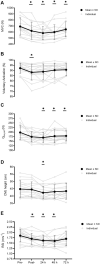Etiology and Recovery of Neuromuscular Function Following Academy Soccer Training
- PMID: 35770192
- PMCID: PMC9235147
- DOI: 10.3389/fphys.2022.911009
Etiology and Recovery of Neuromuscular Function Following Academy Soccer Training
Abstract
Aim: To profile the etiology and recovery time-course of neuromuscular function in response to a mixed-content, standard training week in professional academy soccer players. We concurrently examined physical performance, cognitive function, and perceptual measures of mood and wellness states to identify a range of simple tests applied practitioners could use in the field as surrogate measures of neuromuscular function. Methods: Sixteen professional academy soccer players completed a range of neuromuscular, physical, perceptual, mood, and cognitive function tests at baseline and after a strenuous training day (pitch and gym), with retest at 24, 48, and 72 h, and further pitch and gym sessions after 48 h post-baseline. Maximal voluntary contraction force (MVC) and twitch responses to electrical stimulation (femoral nerve) during isometric knee-extensor contractions and at rest were measured to assess central nervous system (voluntary activation, VA) and muscle contractile (potentiated twitch force, Qtw,pot) function. Results: Strenuous training elicited decrements in MVC force post-session (-11%, p = 0.001) that remained unresolved at 72 h (-6%, p = 0.03). Voluntary activation (motor nerve stimulation) was reduced immediately post-training only (-4%, p = 0.03). No change in muscle contractile function (Qtw,pot) was observed post-training, though was reduced at 24 h (-13%, p = 0.01), and had not fully recovered 72 h after (-9%, p = 0.03). Perceptions of wellness were impaired post-training, and recovered by 24 h (sleepiness, energy) and 48 h (fatigue, muscle soreness, readiness to train). Countermovement jump performance declined at 24 h, while RSI (Reactive Strength Index) decrements persisted at 48 h. No changes were evident in adductor squeeze, mood, or cognitive function. Conclusion: Elite youth soccer training elicits substantial decrements in neuromuscular function, which are still present 72 h post-strenuous exercise. Though central processes contribute to post-exercise neuromuscular alterations, the magnitude and prolonged presence of impairments in contractile function indicates it is the restitution of muscular function (peripheral mechanisms) that explains recovery from strenuous training in academy soccer players.
Keywords: CNS; contractile function; neuromuscular function; peripheral mechanisms; recovery; soccer; voluntary activation.
Copyright © 2022 Deely, Tallent, Bennett, Woodhead, Goodall, Thomas and Howatson.
Conflict of interest statement
The authors declare that the research was conducted in the absence of any commercial or financial relationships that could be construed as a potential conflict of interest.
Figures


References
LinkOut - more resources
Full Text Sources

